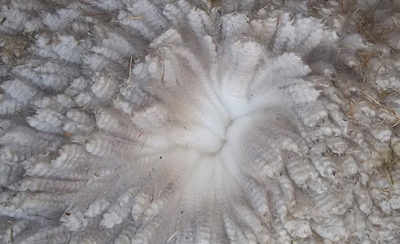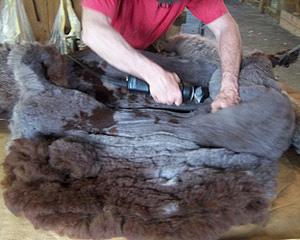Background
Alpacas and alpaca fiber were, for thousands of years, central to the lives and traditions of the native peoples of the Andes. Domestication of wild South American camelids into alpacas resulted in an animal with a dense, uniform coat of fine fiber that is available in more colors than any fiber-producing animal in the world. South America – particularly Peru, Bolivia and Chile – was, and still is, the center of the world’s alpaca fiber industry.
Alpacas have been raised in the United States since the early 1980’s. In a relatively short period of time, North American breeders have made incredible progress in improving the quality of fiber produced by their herds. There are now many small mills in the United States that are specializing in spinning alpaca fiber into tops, roving and luxurious yarns.
 There are two distinct types of alpacas, the Huacaya and the Suri. The differences are apparent in both their physical appearances and their fiber. The Suri alpaca, which has a more angular, slender appearance, has long, lustrous fibers which hang down the body in ringlets. The Huacaya, in contrast, has crimpy fiber which grows perpendicular to the body giving it a rounded, fluffy appearance. Suri fiber is very fine and silky and has no crimp. The average staple length of Suri fiber is 6 to 8 inches. Huacaya fiber appears more sheep-like in that it is soft and fluffy and has crimp. The average staple length of Huacaya fiber is 3 to 5 inches. Huacaya fiber is more abundant and enjoys greater popularity in the world market. Only a small fraction of the world’s alpaca population is Suri.
There are two distinct types of alpacas, the Huacaya and the Suri. The differences are apparent in both their physical appearances and their fiber. The Suri alpaca, which has a more angular, slender appearance, has long, lustrous fibers which hang down the body in ringlets. The Huacaya, in contrast, has crimpy fiber which grows perpendicular to the body giving it a rounded, fluffy appearance. Suri fiber is very fine and silky and has no crimp. The average staple length of Suri fiber is 6 to 8 inches. Huacaya fiber appears more sheep-like in that it is soft and fluffy and has crimp. The average staple length of Huacaya fiber is 3 to 5 inches. Huacaya fiber is more abundant and enjoys greater popularity in the world market. Only a small fraction of the world’s alpaca population is Suri.
Alpaca is a protein fiber and has the same basic structural characteristics as other wools. The outside surface of each fiber is called the cuticle and is covered with tiny scales. There are fewer scales in alpaca fiber than in sheep wool. This means alpaca fiber is less elastic than sheep wool, but also less scratchy. Often, people who are irritated by sheep wool can comfortably wear alpaca. The cortical, or inner structure of the alpaca fiber, is composed of flat and often twisted cells called fibrils. The chemical bonds between the fibrils and within them are the key to the strength and elasticity of the fiber and are affected by the animal’s diet and health as well as environmental factors such as sun, scouring agents and dyes.
Alpaca fibers are medullated, meaning they have a hollow core. Medullation increases with fiber diameter, therefore, the finer alpaca fibers have an interrupted medulla or none at all. This hollow core is what is responsible for the insulating value of alpaca.
Routine Care for Cleaner Fiber
“Groom your pastures, not your alpacas” is the phrase you will generally hear from alpaca owners. Alpacas have a dense coat of fiber that serves to protect them from weather and dirt. In addition, grooming an alpaca’s fleece will disturb the lock formation and make it difficult to properly assess the fleece. Keep your barn and pastures free from materials that may contaminate your alpacas’ fleece. Do not bed your alpacas in sawdust or shavings. Clean, weed-free straw, sand or shredded cardboard bedding work well. Hay may also be used as bedding, but will result in more contamination of the fleece. Just prior to shearing, your alpacas should be picked or blown clean.
Shearing Alpacas
 Alpacas must be shorn annually to avoid health problems caused by overheating and to harvest the fleece at its best. In northern New England, alpacas are shorn when the weather settles in the spring – usually April through June.
Alpacas must be shorn annually to avoid health problems caused by overheating and to harvest the fleece at its best. In northern New England, alpacas are shorn when the weather settles in the spring – usually April through June.
Our farm offers shearing services to a number of alpaca farms. We find that the process goes more smoothly for everyone involved – especially the alpacas! – if the owners know what to expect and are prepared. The following are some tips for getting ready for shearing day. It might be wise to consult your shearer about his or her particular needs.
- Alpacas must be dry to be shorn. If the forecast calls for wet weather, plan to keep your alpacas inside the barn for a few days prior to shearing. To minimize contamination of fleece, alpacas should be kept in the cleanest area available.
- Choose a spot for shearing that is clean, well lit and protected from wind. Make sure electricity is available.
- On shearing day, alpacas should be haltered and prepared for shearing by cleaning as much debris as possible from the fleece. This can be done with wands, blower, vacuum or by hand.
- If you feel any of your alpacas will be especially difficult to handle, consult with your veterinarian about having a sedative available.
- Have enough people on hand to make the shearing process go smoothly. Two people (including the shearer) are barely adequate, especially if your alpacas are skittish. A third person can help restrain alpacas and collect fiber. Check with your shearer to discuss his need for help.
- Be prepared to collect fiber. If you have not already decided on a method for skirting your fiber, we suggest you collect the blanket fiber on a large piece of cardboard. It can then easily be transferred to a sheet of craft paper, a plastic tablecloth or some other material that can be used to roll up the blanket until you have time to skirt it. In addition, we like to use a trash bag (we use clear bags) for each alpaca. Each bag should be labeled with the alpaca’s name, the date and the grade of the fiber – we sort our fiber into “seconds” and “junk”. The “seconds” includes all fiber over about 2″ in length that is not in the blanket. The “junk” is all the short or dirty fibers; all the junk for the day goes into one bag. As you gain experience skirting and decide on uses for your fiber, you will adjust your collection method to suit your needs.
- It is a good idea to shear your alpacas starting with the lightest and working towards the darkest. This minimizes color contamination of the fiber.
Have a broom or shop vac handy to sweep the shearing area clean between alpacas. This will also help to minimize color contamination of the fiber.
Don’t forget to take samples for micron testing, if desired. - You might find that some alpacas are quite warm and their fiber is damp. Be sure to leave the trash bags open and spread those damp fleeces out to dry soon after shearing. A warm, damp fleece tied up in a trash bag may end up a felted mess.
- Take extra care when handling any fleeces that you might want to show.
- If your alpacas are being restrained for shearing, it is also a good time to perform other husbandry tasks such as trimming teeth or toenails and giving shots. If you choose to do this, be prepared so that you are not causing the shearer to wait an excessive amount of time between animals.
- Keep in mind that shearing is a hot, dirty and tiring job. Consider having on hand cold drinks and snacks for your helpers, especially if you are planning a full day of shearing.
- And last but not least, do not forget that we shear our alpacas not only for their health and comfort, but in order to collect and process the luxurious fiber they produce. A number of options are available for dealing with fiber. The sale of alpaca fiber products can be a good source of income for your farm. There is no excuse for letting bags of fiber pile up in the barn!

